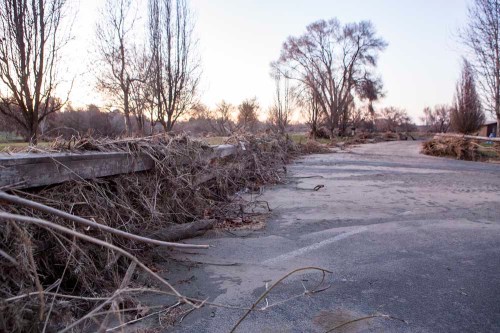Other views: Rationing supplies during a disaster leaves no good choices
Published 6:00 am Saturday, February 6, 2021

- Debris remains tangled in a fence at Riverfront Park in Hermiston on Feb. 27, 2020. The park suffered heavy damage as a result of the flooding of the Umatilla River at the start of February.
The one-year anniversary of Umatilla County’s worst flood in living memory is here, and while the majority of the homes and businesses lost in the flood were concentrated on the east side of the county, readers in western Umatilla County suffered devastating losses too, particularly around the Echo area.
At the time, I thought it would be Eastern Oregon’s defining crisis of the year, perhaps of the decade. But on the heels of the flood came the all-encompassing disaster that is COVID-19, then social unrest and wildfires on an unprecedented scale, and they required resources too. It’s easy to wonder if more state and federal aid might have been rallied for ongoing flood recovery needs if resources weren’t stretched so thin.
When I’ve written stories about disaster preparedness, one thing people who work in emergency management always tell me is that in the event of a disaster, you can’t count on the government to save you.
The government has made plans to save you, of course, as have nonprofits. And for limited disasters, they work pretty well. If your house burns down, the Red Cross will put you up in a hotel that very night. But if all the houses in your town burn down, there will not be hotel rooms available or enough cots in school gyms to go around. We saw that happen with the Southern Oregon wildfires this summer, as police evicted people pitching tents in city parks.
Personal preparedness can do wonders for help filling in those time gaps. If the water supply in a city is cut off or becomes unsafe to drink, for example, storing extra cases of bottled water gives you breathing room if it takes three days for trucks of bottled water to arrive in town.
The question, however, becomes how things should be handled if those coming to the rescue have limited resources.
This is been thrown into sharp relief during the pandemic, as the United States hasn’t had nearly enough personal protective equipment, COVID-19 tests or vaccines for everyone who needs them. The result has been the government making decisions on how to ration lifesaving supplies.
The latest battlefront in that debate — vaccines — has generated significant controversy. Rural counties, such as Morrow County, argue it is unfair they are receiving fewer vaccine doses per capita than more populous counties, despite having higher rates of COVID-19 that put their vulnerable residents in more imminent danger. Metro counties argue it’s not fair for smaller counties to be able to move ahead to vaccinating new categories of eligibility before they finish vaccinating people in categories deemed more urgent.
So far, the big counties are winning that argument.
This has implications far beyond COVID-19. As the pandemic recedes, Eastern Oregon counties should be asking hard questions about the plan for rationing resources in other potential widespread disasters.
Those crises may include natural disasters — earthquakes, volcanoes, tsunamis, storms, floods or fires — or man-made ones, such as a massive industrial disaster or a terror attack on our electrical grid.
If a Cascadia earthquake destroys roads and buildings, sends Oregon’s fuel reserves sliding into the Willamette River and knocks out power to the entire state, what is the plan for generators, gasoline and other supplies that begin to arrive from other states? And is that plan a mandate or a suggestion easily tossed aside?
It’s easy to talk about equity in Oregon, but when push comes to shove, Eastern Oregon counties will always need to be jockeying for position with other parts of the state. In the meantime, the best strategy may be to make what preparations we can to help ourselves.
Do you have a point you’d like to make or an issue you feel strongly about? Submit a letter to the editor or a guest column.









